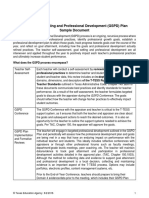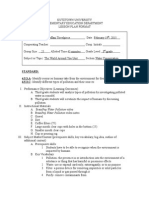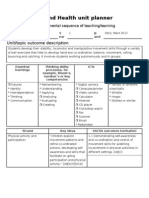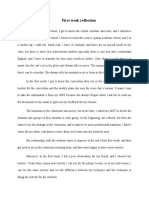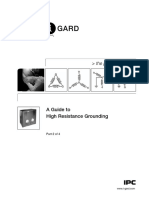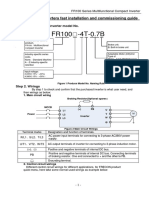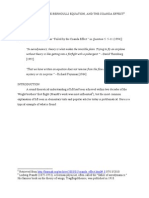Sce 5e Lesson Plan
Sce 5e Lesson Plan
Uploaded by
api-324298557Copyright:
Available Formats
Sce 5e Lesson Plan
Sce 5e Lesson Plan
Uploaded by
api-324298557Original Title
Copyright
Available Formats
Share this document
Did you find this document useful?
Is this content inappropriate?
Copyright:
Available Formats
Sce 5e Lesson Plan
Sce 5e Lesson Plan
Uploaded by
api-324298557Copyright:
Available Formats
USF Elementary Education Lesson Plan Template
Grade Level Being Taught: Subject/Content: Science
K
Group
Size:
Name: ____
Date of Lesson:
Lesson Content
What Standards (national
or state) relate to this
lesson?
(You should include ALL
applicable standards. Rarely
do teachers use just one:
theyd never get through
them all.)
Essential Understanding
(What is the big idea or
essential question that you
want students to come away
with? In other words, what,
aside from the standard and
our objective, will students
understand when they finish
this lesson?)
Science Content Standard:
SC.K.N.1.3 Keep records as appropriatesuch as pictorial recordsof investigations
conducted.
SC.K.N.1.5 Recognize that learning can come from careful observation.
SC.K.E.5.1- Explore the Law of Gravity by investigating how objects are pulled toward the
ground unless something holds them up.
Essential question:
What force makes objects fall back to the ground?
Science concept:
Gravity is a force
Process skills/science practices:
MW: What one piece will
students walk away with
understanding after engaging
in this lesson?
Objectives- What are you
teaching?
(Student-centered: What will
students know and be able to
do after this lesson? Include
the ABCDs of objectives:
action, behavior, condition,
and degree of mastery, i.e.,
"C: Given a sentence written
Observing, predicting, communicating, and interpreting data
Nature of Science: Science is social and Science explains and predicts
USF Elementary Education Lesson Plan Template
Grade Level Being Taught: Subject/Content: Science
K
Group
Size:
Name: ____
Date of Lesson:
in the past or present tense,
A: the student B: will be able
to re-write the sentence in
future tense D: with no errors
in tense or tense contradiction
(i.e., I will see her
yesterday.)."
Note: Degree of mastery does
not need to be a percentage.)
Rationale
Address the following
questions:
Why are you teaching this
objective?
Where does this lesson fit
within a larger plan?
(Within grade level AND K5 education)
Why are you teaching it
this way?
Why is it important for
students to learn this
concept?
Evaluation Plan- How will
you know students have
mastered your objectives?
Address the following:
What formative evidence
will you use to document
student learning during
EACH phase of the lesson?
What summative evidence
I am teaching this objective because students need to learn the basics of why objects fall
back down to ground. This lesson fits within a larger plan because at this stage
kindergartners are learning the basics of gravity without being introduced to the in depth
perspective of gravity. This will allow students to know what gravity is and what it does,
but later get to know the different ways gravity works.
I am teaching gravity using the 5Es, it allows students to become engage and become
scientists themselves by being able to explore the force itself. I believe this concept is
important for students to learn because it teaches the broader concept of gravity making
it easier to narrow as they move through their school careers.
This is the first standard that is introduced to kindergartners for Earth in Space and Time
before learning about anything else within Big Idea 5 of Earth in Space and Time.
Formative Assessment:
- Student Checklist During the Engage portion of the lesson, students will be asked
why they were not able to make it to the moon by jumping. I will have students
demonstrate thumbs up or thumbs down after being asked if they knew what gravity is.
- Student Checklist During the Explore portion of the lesson, students will be asked
questions on their predictions they are making as the investigation takes place to see
what students are grasping.
- Student Checklist During the Explain portion of the lesson, students will be asked to
demonstrate with an unsharpened pencil if it is placed on their head why it prevents it
USF Elementary Education Lesson Plan Template
Grade Level Being Taught: Subject/Content: Science
K
will you collect, either
during this lesson or in
upcoming lessons? Be sure
to include a scoring guide.
Group
Size:
Name: ____
Date of Lesson:
from falling. This will allow students to investigate it first then apply their knowledge.
- Student Checklist During the Extend portion of the lesson, students will be
performing the Gravity song where they will need to demonstrate the movements of
what happens when objects come in contact with Gravity.
- Student Checklist During the Evaluation portion of the lesson, students will be asked
to share a fact or something interesting that they learned about Gravity in their science
journals. It can either be drawn or written.
Summative Assessment:
- Gravity Worksheet At the end if the week lesson, students will complete a Gravity
worksheet that will ask students to circle objects that gravity will pull back to the ground
in green, and objects that are found in the sky and that gravity does not pull to the
ground in blue.
Scoring Guide:
- Making sure that students use the correct coloring crayons
- Name is at the top of their paper
- If an object is circle of the opposite color, making sure they are able to explain their
reasoning.
What Content Knowledge
is necessary for a teacher
to teach this material?
Be sure to cite all
resources you used to
learn the content
Teachers need to know what Gravity is, its definition, and how it impacts students life at
this age to make it relatable. Teachers need to be prepared to answer questions students
at this age may have, which may be Why do stars stay in the sky? How do astronauts
make it to space when there is Gravity?
Gravity or gravitational forces are forces of attraction. We're not talking about finding
someone really cute and adorable. It's like the Earth pulling on you and keeping you on
the ground. That pull is gravity at work.
They Always ask About Feathers
People always say, "What about feathers? They fall so slowly." Obviously, there is air all
around us. When a feather falls, it falls slowly because the air is in its way. There is a lot
of air resistance and that resistance makes the feather move slower. The forces at work
are the same. If you dropped a feather in a container with no air (a vacuum), it would
drop as fast as a baseball.
What About the Moon?
USF Elementary Education Lesson Plan Template
Grade Level Being Taught: Subject/Content: Science
K
Group
Size:
Name: ____
Date of Lesson:
But what keeps the Moon from falling down, if all of this gravity is so strong? Well, the
answer is that the moon IS falling; all the time, but doesn't get any closer to us!
Studios, A. R. (n.d.). Forces of Attraction. Retrieved November 18, 2016, from
http://www.physics4kids.com/files/motion_gravity.html
What happens when you throw a ball? In this movie, Annie and Moby explore the force of
gravity. You'll learn that mass is the amount of matter in something, and weight
measures how much gravity is pulling on an object. Did you know that objects with
greater mass have a stronger force of gravity? Find out how much things would weigh on
other planets!
Gravity Lesson Plans and Lesson Ideas | BrainPOP Educators. (n.d.). Retrieved
November 18, 2016, from https://educators.brainpop.com/bp-jr-topic/gravity/
What background
knowledge is necessary for
a student to successfully
meet these objectives?
How will you ensure
students have this
previous knowledge?
Who are your learners?
What do you know about
them?
What do you know about
their readiness for this
content?
What misconceptions
might students have about
this content?
- Due to the fact that we will be only covering gravity and not density of objects, students
may think that not all objects fall at the same time or speed.
Lesson Implementation
USF Elementary Education Lesson Plan Template
Grade Level Being Taught: Subject/Content: Science
K
Teaching Methods
(What teaching method(s) will
you use during this lesson?
Examples include guided
release, 5 Es, direct
instruction, lecture,
demonstration, partner word,
etc.)
Group
Size:
Name: ____
Date of Lesson:
You will utilize the 5E teaching model for this lesson. Below, write out the purpose for
each phase of the 5E model.
Engage- This will be the hook to getting students to become motivated in the content
that will be covered.
Explore- During this stage, students will become scientist and be able to explore Gravity
for themselves as well as talk to their partners about their predictions.
Explain- Students will be able to get to learn more about gravity and share their
thoughts.
Extend- Students will be performing the gravity song to help them get a better
understanding of gravity and what it does.
Evaluation- Accomplish by asking students to draw or write what they learned about
gravity.
NOS: The nature of science principles includes science is social; students will be able to
share their thoughts with their classmates about gravity. Science explains and predicts,
where students will be able to predict the outcomes of their investigation and also
explain their outcome as they interpret the data on their observation sheet.
Processing Skills: Students will be using the process skill of observing, predicting,
communicating, and interpreting data.
Step-by-Step Plan
(What exactly do you plan to
do in teaching this lesson? Be
thorough. Act as if you needed
a substitute to carry out the
lesson for you.)
Where applicable, be sure to
address the following:
What Higher Order
Thinking (H.O.T.) questions
will you ask?
How will materials be
Time
Who is
responsibl
e (Teacher
or
Students)?
Each content area may require a different step-by-step format. Use
whichever plan is appropriate for the content taught in this lesson.
For example, in science, you would detail the 5 Es here
(Engage/Encountering the Idea; Exploring the Idea;
Explanation/Organizing the Idea; Extend/Applying the Idea;
Evaluation).
2 min Student-Centered
Engage - All of the students will be asked to stand up on the carpet
to take a trip to the moon. Ok students, we will be jumping as high
as we can to be able to take a trip to the moon. 1, 2, and go.
Everyone will try to jump but go nowhere. Ask student what
USF Elementary Education Lesson Plan Template
Grade Level Being Taught: Subject/Content: Science
K
distributed?
Who will work together in
groups and how will you
determine the grouping?
How will students
transition between
activities?
What will you as the
teacher do?
What will the students do?
What student data will be
collected during each
phase?
What are other adults in
the room doing? How are
they supporting students
learning?
What model of co-teaching
are you using?
Group
Size:
Name: ____
Date of Lesson:
happened and why they did not reach the moon. Allow students to
answer. Ask students to give you thumbs up if they know what
gravity is and thumbs down if they dont. Mark the results on the
clipboard
10 min Student/Teacher-Centered
Explore After the moon trip have everyone sit on the carpet in U
formation. Take out the green bulletin paper and place it in the
middle of the carpet so students can see the objects better. After
you have all the objects, let students know that they will all become
scientists where we will be conducting an investigation race to see
which item will hit the ground first. Let students know that they will
be provided with an observation sheet where scientists write their
evidence because science demands evidence. Tell students that
they will be predicting first which item will touch the ground first,
share with their thought with their side partner and then observe
the action. They will then turn to their partner to discuss if their
prediction was correct and let them know why they were right or
wrong by interpreting the data.
15-20 min Teacher-Centered
Explain After finishing the investigation, ask students to get into
ELMO squares. Read How do we stay on Earth? And ask probing
questions throughout as well as asking what if questions.
-What if there were no gravity on earth, what do you think would
happen?
- What if you went to the moon what do you think would happen?
Vocabulary: Gravity, force, and Mass
5-7 min Student-Centered
Extend After wrapping up the book, ask students to stand up on
their regular squares and get ready for the Gravity song. Go over it
the first time with the movements, and then allow for students to
join in the second and third time around. Make sure all students are
performing what gravity does to objects.
USF Elementary Education Lesson Plan Template
Grade Level Being Taught: Subject/Content: Science
K
Group
Size:
Name: ____
Date of Lesson:
Students will also be making up their movements to the song to
asses their knowledge of what gravity does.
5 min Student-Centered
Evaluation At this point, have students take a seat on their
squares and let them know that they will be writing and/or drawing
about what they learned or found interesting about gravity. Have
students collect their notebooks, go to their regular desk seats, and
begin.
What will you do if
a student struggles with the content?
What will you do if
a student masters the content quickly?
Meeting your students
needs as people and as
learners
If applicable, how does this lesson connect to the interests and cultural
backgrounds of your students?
This lesson connects to students interests or background because it included things
within the lesson that they could relate to in their life. The objects that were used in the
gravity investigation all came from students surroundings in class.
If applicable, how does this lesson connect to/reflect the local community?
This lesson connects to the local community within the classroom. This lesson allows
students to communicate their thinking to one another, and allows for students to build
their classroom community further by sharing those thoughts and ideas.
How will you differentiate instruction for students who need additional
challenge during this lesson (enrichment)?
USF Elementary Education Lesson Plan Template
Grade Level Being Taught: Subject/Content: Science
K
Group
Size:
Name: ____
Date of Lesson:
How will you differentiate instruction for students who need additional
language support?
Accommodations (If
needed)
(What students need specific
accommodation? List
individual students (initials),
and then explain the
accommodation(s) you will
implement for these unique
learners.)
Materials
(What materials will you use?
Why did you choose these
materials? Include any
resources you used. This can
also include people!)
Observation Sheet
Materials for the investigation: Feather, Rock, Ball, Book, Paper clip, Quarter, Paper,
Pencil, Cotton Ball, and Toy car.
Gravity Song sheet
Gravity Worksheet Students will be read the worksheet and given directions
on what to do. To allow students to succeed, the directions given will be:
circle the objects in green that gravity pulls back to Earth, and circle the
objects in blue that gravity does not pull back to Earth.
*For safety precautions, the teacher will be dropping the items at a low level
and a safe distance from the students *
USF Elementary Education Lesson Plan Template
Grade Level Being Taught: Subject/Content: Science
K
Group
Size:
Name: ____
Date of Lesson:
Name: ______________________________
Gravity Observation Sheet
Trial
#1
Trial
#2
Trial
#3
Feather
Rock
Ball
Book
Paper Clip
Quarter
USF Elementary Education Lesson Plan Template
Grade Level Being Taught: Subject/Content: Science
K
Trial
#4
Trial
#5
Paper
Cotton Ball
Group
Size:
Name: ____
Date of Lesson:
Pencil
Toy Car
USF Elementary Education Lesson Plan Template
Grade Level Being Taught: Subject/Content: Science
K
Na m e:
Group
Size:
__________________
GRAVITY
Color the objects below the following colors:
GREEN: objects that are found in the sky and return to Earth
BLUE: objects that are found in the sky and do not come back to Earth
spaceship
cloud
planet
bird
sun
hot air balloon
airplane
stars
moon
kite
St
Name: ____
Date of Lesson:
USF Elementary Education Lesson Plan Template
Grade Level Being Taught: Subject/Content: Science
K
Group
Size:
Name: ____
Date of Lesson:
You might also like
- GSPD Sample DocumentDocument5 pagesGSPD Sample DocumentAirah Santiago100% (1)
- Child Observation Record ReflectionDocument14 pagesChild Observation Record Reflectionapi-30263259850% (4)
- Read Aloud LessonDocument4 pagesRead Aloud Lessonapi-298250353No ratings yet
- Family Engagement Plan PaperDocument6 pagesFamily Engagement Plan Paperapi-354741670No ratings yet
- Assessment 1: Essay On The Foundation of Teaching and LearningDocument10 pagesAssessment 1: Essay On The Foundation of Teaching and Learningapi-408498483No ratings yet
- Water Conservation LessonDocument4 pagesWater Conservation Lessonapi-269984318No ratings yet
- Formal Observation Report 1 1Document8 pagesFormal Observation Report 1 1api-535562565No ratings yet
- Edu 144 Portfolio Case Study ObservationsDocument10 pagesEdu 144 Portfolio Case Study Observationsapi-249260151No ratings yet
- HW1 SolDocument4 pagesHW1 SolRanga GuraniNo ratings yet
- Science PlanDocument12 pagesScience PlanmissedmondsNo ratings yet
- Teacher Goal Setting Guide Ach First 17JAN2013Document10 pagesTeacher Goal Setting Guide Ach First 17JAN2013farah nazNo ratings yet
- English Planning Term 2 - CarrianneDocument22 pagesEnglish Planning Term 2 - Carrianneapi-315385324No ratings yet
- Measurement Unit PlanDocument18 pagesMeasurement Unit Planapi-482110307No ratings yet
- What Are GermsDocument7 pagesWhat Are Germsapi-297915929No ratings yet
- Samr Goal SettingDocument4 pagesSamr Goal Settingapi-405695853100% (1)
- Melting and Freezing ReviewDocument10 pagesMelting and Freezing Reviewapi-300813801No ratings yet
- Child Development Ed 698 Gillian 2020 Final VersionDocument16 pagesChild Development Ed 698 Gillian 2020 Final Versionapi-354856291No ratings yet
- Maddie Koontz Educ 424A Dr. Mckenzie Unit Plan: 1St Grade 2/11/2016Document9 pagesMaddie Koontz Educ 424A Dr. Mckenzie Unit Plan: 1St Grade 2/11/2016api-309172857No ratings yet
- Mentor Text Writing Lesson PlanDocument5 pagesMentor Text Writing Lesson Planapi-349264901No ratings yet
- Anecdotal Record KohlmannDocument3 pagesAnecdotal Record Kohlmannapi-247068331No ratings yet
- Book Lesson PlanDocument4 pagesBook Lesson Planapi-5492559780% (1)
- Preschool Lesson Plan 3Document9 pagesPreschool Lesson Plan 3api-341105610No ratings yet
- Teacher Goal-Setting SISDDocument44 pagesTeacher Goal-Setting SISDMRMFARAHNo ratings yet
- Bee Lesson Plan 2 Used in PortfolioDocument6 pagesBee Lesson Plan 2 Used in Portfolioapi-200448079No ratings yet
- English Recount Lesson PlanDocument3 pagesEnglish Recount Lesson Planapi-512914640No ratings yet
- Literacy Lesson Plan First DraftDocument5 pagesLiteracy Lesson Plan First DraftMelina VarneyNo ratings yet
- Edtpa Lesson Plan Honey BeeDocument2 pagesEdtpa Lesson Plan Honey Beeapi-253338725No ratings yet
- PE - BALL SKILLS Unit Plan Year 1Document9 pagesPE - BALL SKILLS Unit Plan Year 1mbed2010100% (1)
- Edu 220 Cooperative Learning Lesson PlanDocument6 pagesEdu 220 Cooperative Learning Lesson Planapi-533889645No ratings yet
- Artifact2 Field Observation and ReflectionDocument6 pagesArtifact2 Field Observation and Reflectionapi-549623622No ratings yet
- Maths Unit Plan: Curriculum LinksDocument8 pagesMaths Unit Plan: Curriculum Linksapi-465432008No ratings yet
- Bet McCallum Formative Assessment PDFDocument14 pagesBet McCallum Formative Assessment PDFchrisNo ratings yet
- Learning Experience Plan MusicDocument3 pagesLearning Experience Plan Musicapi-499717349No ratings yet
- Sorting Lesson PlanDocument4 pagesSorting Lesson Planapi-267077176No ratings yet
- Lesson Plan Direct InstructionDocument5 pagesLesson Plan Direct Instructionapi-349767644No ratings yet
- Grable Professional InterviewDocument12 pagesGrable Professional Interviewapi-446296019No ratings yet
- Educ 4731 Ang Cai Wen Assignment 2Document35 pagesEduc 4731 Ang Cai Wen Assignment 2api-404770159100% (1)
- Lesson Plan 1 Bees Used in PortfolioDocument7 pagesLesson Plan 1 Bees Used in Portfolioapi-200448079No ratings yet
- PBL 2Document6 pagesPBL 2api-245618331No ratings yet
- Philosophy of LiteracyDocument8 pagesPhilosophy of Literacyapi-236468149No ratings yet
- Observation Lesson KindergartenDocument2 pagesObservation Lesson Kindergartenapi-284103669No ratings yet
- Infant Room Observation-4Document4 pagesInfant Room Observation-4api-2673479910% (1)
- Running Head: ECERS Assignment 1Document8 pagesRunning Head: ECERS Assignment 1api-300862751No ratings yet
- Lesson Plan 3Document3 pagesLesson Plan 3api-267963208No ratings yet
- Meeting The Aitsl StandardsDocument1 pageMeeting The Aitsl Standardsapi-269236462No ratings yet
- Seton Hill University Lesson Plan Template: Name Subject Grade Level Date/DurationDocument4 pagesSeton Hill University Lesson Plan Template: Name Subject Grade Level Date/Durationapi-279823017No ratings yet
- My Teaching PhilosophyDocument3 pagesMy Teaching PhilosophyMariah CummingsNo ratings yet
- Case Study Assignment 2Document10 pagesCase Study Assignment 2api-408336810No ratings yet
- Edu 220 Lesson Plan 1Document5 pagesEdu 220 Lesson Plan 1api-459689790No ratings yet
- Portfolio School of Education Professional DispositionsDocument4 pagesPortfolio School of Education Professional Dispositionsapi-554373722No ratings yet
- Kindergarten Science LessonDocument16 pagesKindergarten Science Lessonapi-351979305No ratings yet
- Gems 5-E Lesson Plan 1Document12 pagesGems 5-E Lesson Plan 1Geovannie RetiroNo ratings yet
- Lesson Plan For Observation On 2-10-16Document10 pagesLesson Plan For Observation On 2-10-16api-320426519No ratings yet
- Assignment Behaviourist PrinciplesDocument11 pagesAssignment Behaviourist PrinciplesSyamimi Zolkepli0% (1)
- Ers Narrative RevisedDocument7 pagesErs Narrative Revisedapi-596349166No ratings yet
- Lesson Plan - Trista Cain RevisedDocument3 pagesLesson Plan - Trista Cain Revisedapi-348113052No ratings yet
- Direct Instruction Lesson PlanDocument4 pagesDirect Instruction Lesson Planapi-579612045No ratings yet
- Social Cognitive Theory Lesson PlanDocument5 pagesSocial Cognitive Theory Lesson Planapi-240286998100% (1)
- Reflection 1Document2 pagesReflection 1api-307772341No ratings yet
- Access to Life Science: Investigation Starters for Preschool, Kindergarten and the Primary GradesFrom EverandAccess to Life Science: Investigation Starters for Preschool, Kindergarten and the Primary GradesNo ratings yet
- Early Science Education – Goals and Process-Related Quality Criteria for Science TeachingFrom EverandEarly Science Education – Goals and Process-Related Quality Criteria for Science TeachingRating: 5 out of 5 stars5/5 (1)
- Electrical Machines and Power Electronics: ENEE4301Document62 pagesElectrical Machines and Power Electronics: ENEE4301omarNo ratings yet
- HRG Guide Part 2of4Document6 pagesHRG Guide Part 2of4janarthananNo ratings yet
- My Understanding of VethathiriumDocument8 pagesMy Understanding of VethathiriumJaganathan KNo ratings yet
- Physics SD 11.11 Phys.7BDocument38 pagesPhysics SD 11.11 Phys.7Bxavierlewis458No ratings yet
- College Physics A Strategic Approach 3rd Edition Knight Solutions Manual 1Document32 pagesCollege Physics A Strategic Approach 3rd Edition Knight Solutions Manual 1tracy100% (51)
- Current & Voltage TransformerDocument43 pagesCurrent & Voltage Transformermeraat100% (1)
- 4 CVTDocument2 pages4 CVTjkhan_724384No ratings yet
- FR100 Series User Manual EN V1.320150325Document121 pagesFR100 Series User Manual EN V1.320150325MD SHAHIN MIANo ratings yet
- Optimize Magnetic GapDocument45 pagesOptimize Magnetic GapteomondoNo ratings yet
- Multipurpose Machines Using Scotch Yoke MechanismDocument36 pagesMultipurpose Machines Using Scotch Yoke Mechanismnithinkenator88% (16)
- IV Report NewDocument83 pagesIV Report Newsruthy100% (2)
- Tic 300 Pro Tic TracerDocument2 pagesTic 300 Pro Tic Traceredwin-cuchieyesNo ratings yet
- Science Worksheet Unit 8Document4 pagesScience Worksheet Unit 8Lia FransiscaNo ratings yet
- Magnetic Field Due To Current Carrying Conductor (MCQ) - Electrical Study ADocument10 pagesMagnetic Field Due To Current Carrying Conductor (MCQ) - Electrical Study Ajyotiranjan sahooNo ratings yet
- Section 2 Three Phase Power FundamentalsDocument112 pagesSection 2 Three Phase Power FundamentalsAhmedNo ratings yet
- Chapter 1Document72 pagesChapter 1sunilkumareceNo ratings yet
- Kinematics of Particles Plane Curvilinear MotionDocument16 pagesKinematics of Particles Plane Curvilinear Motionson gokuNo ratings yet
- Lecture 7-Fullwave RectifiersDocument27 pagesLecture 7-Fullwave RectifiersSanjyoti DasNo ratings yet
- Superposition Theorem For DC CircuitsDocument21 pagesSuperposition Theorem For DC CircuitsGyan Ranjan KumarNo ratings yet
- T.L.E 7 and 8 Week 5Document15 pagesT.L.E 7 and 8 Week 5Eleonor DistrajoNo ratings yet
- History of Electricity: DR Chua Kein HuatDocument8 pagesHistory of Electricity: DR Chua Kein Huatkeinhuat79No ratings yet
- Winding Turn Turn Failures and Testing PDFDocument3 pagesWinding Turn Turn Failures and Testing PDFJosé SánchezNo ratings yet
- Electrical Machines Test Questions Set - 7 Electrical Machines Test Questions Set - 7Document17 pagesElectrical Machines Test Questions Set - 7 Electrical Machines Test Questions Set - 7पंकज काळेNo ratings yet
- Shunt ReactorDocument29 pagesShunt ReactorbulbllNo ratings yet
- Forces and Motion Lab ReportDocument7 pagesForces and Motion Lab ReportShaimaa SalamaNo ratings yet
- Guide+How+to+Apply+for+Electricity+Connection Oct+2018Document132 pagesGuide+How+to+Apply+for+Electricity+Connection Oct+2018Jinxian XuNo ratings yet
- Basics of Dynamic ElectrochemistryDocument15 pagesBasics of Dynamic ElectrochemistryNaresh Chavan50% (2)
- Jef Raskin - Coanda EffectDocument17 pagesJef Raskin - Coanda EffectOdobenusNo ratings yet
- Bs Civil Engineering Cagayan State University - CarigDocument40 pagesBs Civil Engineering Cagayan State University - CarigSamantha CusiNo ratings yet
